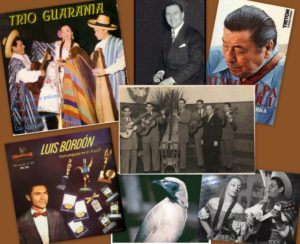Golden Age of Exotica, collected by Henk Braaksma.
The Harpists of PARAGUAY part 6: PÁJARO CAMPANA
On 8 June 2010, the then President of Paraguay Fernando Lugo Méndez officially proclaimed the harp of Paraguay as ‘The Symbol of the Musical Culture of Paraguay’. The harp was brought to South America by the Jesuits from Spain around 1700. The harp developed in different ways – specifically in the style of play – in South American countries such as Mexico and Venezuela, but especially in Paraguay. Around 1950, Paraguay introduced the harp in its perfect form in The West and caused a true revolution there. It had become such a beautiful instrument, and the tone was so pure. Hundreds of ensembles travelled to Europe, of which the Trío Los Paraguayos became the most famous. All of the Paraguayan folk music was played with a harp, and therefore it became an indispensable attribute for this music. But also in Paraguay, progress could not be stopped and the harp threatened to be supplanted by the electronic keyboard. But that could not happen and with combined forces the harp eventually received its status it has because of the proclamation of 8 June 2010, thanks to propaganda, education, and festivals.
After the running start of the singing duo AGUILERA-BRITEZ, we continue with the 14th harpist from our series: LUÍS BORDÓN, an old acquaintance of ours because Concertzender had broadcast a 3-part programme since 3 July 2015, and you can still listen to it! Then, we continue with a duo without a harpist LES GUARANA, but by then we are close to the principal guest of our programmes FÉLIX PÉREZ CARDOZO. Yet, the duo provided a harpist, so we were able to close that space with ALBINO QUIÑÓNEZ, who could be found in French from a very early stage.
However, everything in Paraguay revolves around the harpist who, with his activities but especially with his compositions (including the famous Pájaro campana) made the harp globally known. His birthplace HY’ATY was even renamed FÉLIX PÉREZ CARDOZO. And there could not be more acknowledgement for an important person.

Speellijst:
1) Iporamante cambá, polca – Dúo Aguilera-Britez
(Manuel Romero Villazanti) – Festival en el Paraguay – Asunción A 1003
2) Virgencita de Caäcupé, polca [014) – Luís Bordón
(Federico Riera) – Chantecler CMG 2.113 (1963)
3) Cruzando nubes, polca – Luís Bordón (-) Marpar 33324 (1958)
4) Chiñi (Nair), polca – Luís Bordón(Ignacio Melgarejo) – Disk Jockey LD 15113
5) Angel de la Sierra, purajhei – Les Guarania
(E.B.Cáceres-C.Miguel Giménez) – Folklore Sud Americain – MFP MFP 5084 (1957)
6) Teresita – [015] (Trío Guaranía)
(Albino Quiñónez) – A Traves la Cordillére des Andes – Ducretet-Thomson 250 V 108 (1959)
7) Trompo’ i yeroki, harpsolo – Trío Guaranía
(Albino Quiñónez) – A Traves la Cordillére des Andes – Ducretet-Thomson 250 V 108 (1959)
8) Nenequita – Hnos. Cáceres (1940-44) (Carlos M. Jiménez, E.B . Cáceres)
9) Che pochyma nendive – Hnos. Cáceres (1940-44)
(Emiliano R. Fernández, Félix Pérez Cardozo)
10) Che yvoty mombyry, polca – Dúo Larramendia-Cáceres (1940-44)
(C.M. Jiménez, Fidelinio Castro)
11) Angela Rosa, Galopa – [016] Félix Pérez Cardozo (Odeón Colección 4156)
12) Asunción, canción – María Teresa Marquez, vocal – Félix Pérez Cardozo
(F. Riera) – Los Éxitos de… – Odeón 4156
13) Pájaro Campana – Arpa Paraguaya (mét de vogel Guayrá Pong)
14) Pájaro campana, polca paraguaya
(Motivo onomatopéyico (Arr.FPC)) – Félix Pérez Cardozo – Pájaro Campana – Odeón DMO 55476
15) Pájaro Campana – Facio Santillán, quena Riviera 521 133 (1965)
16) Pájaro campana – Amaya, Luís (guitarra) Live (1967) in Holland
17) Oración para Pérez Cardozo – Atahualpa Yupanqui
Atahualpa Yupanqui – Recital de Guitarra – Triton (CC) T 64 (1978)
18) Victoria, polca [016] – Félix Pérez Cardozo
(Félix Pérez Cardozo) Tardes Aunceñas – Caravelle 70.250
19) Colorado, polca paraguay – Félix Pérez Cardozo
(F.P.Cardozo (motivo popular) – Pérez Cardozo, Félix – Pájaro Campana – Odeón DMO 55476








